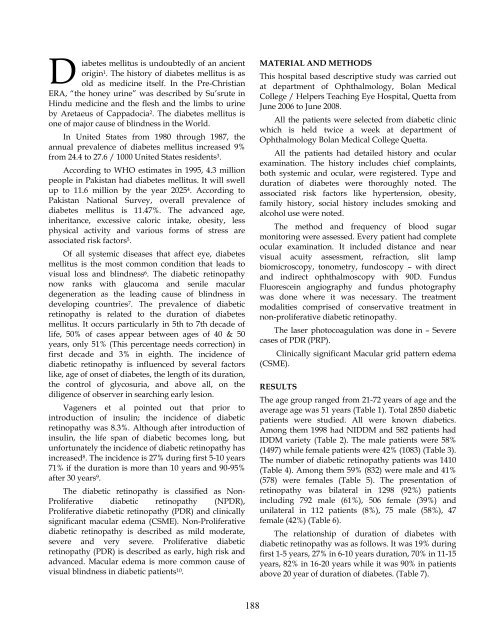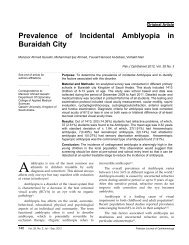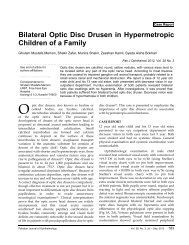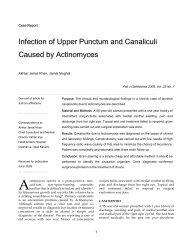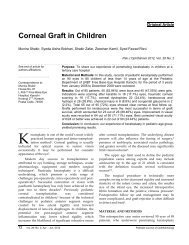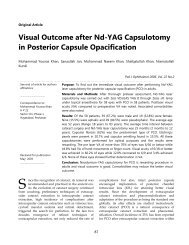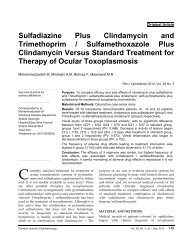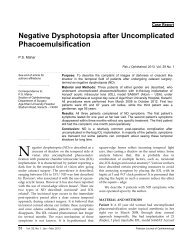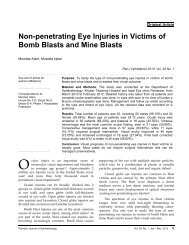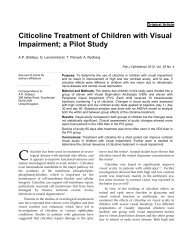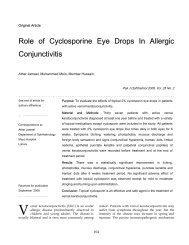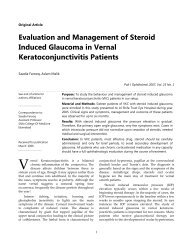Prevalence of Diabetic Retinopathy in Quetta Balochistan - Pakistan ...
Prevalence of Diabetic Retinopathy in Quetta Balochistan - Pakistan ...
Prevalence of Diabetic Retinopathy in Quetta Balochistan - Pakistan ...
Create successful ePaper yourself
Turn your PDF publications into a flip-book with our unique Google optimized e-Paper software.
D<br />
iabetes mellitus is undoubtedly <strong>of</strong> an ancient<br />
orig<strong>in</strong> 1 . The history <strong>of</strong> diabetes mellitus is as<br />
old as medic<strong>in</strong>e itself. In the Pre-Christian<br />
ERA, “the honey ur<strong>in</strong>e” was described by Su’srute <strong>in</strong><br />
H<strong>in</strong>du medic<strong>in</strong>e and the flesh and the limbs to ur<strong>in</strong>e<br />
by Aretaeus <strong>of</strong> Cappadocia 2 . The diabetes mellitus is<br />
one <strong>of</strong> major cause <strong>of</strong> bl<strong>in</strong>dness <strong>in</strong> the World.<br />
In United States from 1980 through 1987, the<br />
annual prevalence <strong>of</strong> diabetes mellitus <strong>in</strong>creased 9%<br />
from 24.4 to 27.6 / 1000 United States residents 3 .<br />
Accord<strong>in</strong>g to WHO estimates <strong>in</strong> 1995, 4.3 million<br />
people <strong>in</strong> <strong>Pakistan</strong> had diabetes mellitus. It will swell<br />
up to 11.6 million by the year 2025 4 . Accord<strong>in</strong>g to<br />
<strong>Pakistan</strong> National Survey, overall prevalence <strong>of</strong><br />
diabetes mellitus is 11.47%. The advanced age,<br />
<strong>in</strong>heritance, excessive caloric <strong>in</strong>take, obesity, less<br />
physical activity and various forms <strong>of</strong> stress are<br />
associated risk factors 5 .<br />
Of all systemic diseases that affect eye, diabetes<br />
mellitus is the most common condition that leads to<br />
visual loss and bl<strong>in</strong>dness 6 . The diabetic ret<strong>in</strong>opathy<br />
now ranks with glaucoma and senile macular<br />
degeneration as the lead<strong>in</strong>g cause <strong>of</strong> bl<strong>in</strong>dness <strong>in</strong><br />
develop<strong>in</strong>g countries 7 . The prevalence <strong>of</strong> diabetic<br />
ret<strong>in</strong>opathy is related to the duration <strong>of</strong> diabetes<br />
mellitus. It occurs particularly <strong>in</strong> 5th to 7th decade <strong>of</strong><br />
life, 50% <strong>of</strong> cases appear between ages <strong>of</strong> 40 & 50<br />
years, only 51% (This percentage needs correction) <strong>in</strong><br />
first decade and 3% <strong>in</strong> eighth. The <strong>in</strong>cidence <strong>of</strong><br />
diabetic ret<strong>in</strong>opathy is <strong>in</strong>fluenced by several factors<br />
like, age <strong>of</strong> onset <strong>of</strong> diabetes, the length <strong>of</strong> its duration,<br />
the control <strong>of</strong> glycosuria, and above all, on the<br />
diligence <strong>of</strong> observer <strong>in</strong> search<strong>in</strong>g early lesion.<br />
Vageners et al po<strong>in</strong>ted out that prior to<br />
<strong>in</strong>troduction <strong>of</strong> <strong>in</strong>sul<strong>in</strong>; the <strong>in</strong>cidence <strong>of</strong> diabetic<br />
ret<strong>in</strong>opathy was 8.3%. Although after <strong>in</strong>troduction <strong>of</strong><br />
<strong>in</strong>sul<strong>in</strong>, the life span <strong>of</strong> diabetic becomes long, but<br />
unfortunately the <strong>in</strong>cidence <strong>of</strong> diabetic ret<strong>in</strong>opathy has<br />
<strong>in</strong>creased 8 . The <strong>in</strong>cidence is 27% dur<strong>in</strong>g first 5-10 years<br />
71% if the duration is more than 10 years and 90-95%<br />
after 30 years 9 .<br />
The diabetic ret<strong>in</strong>opathy is classified as Non-<br />
Proliferative diabetic ret<strong>in</strong>opathy (NPDR),<br />
Proliferative diabetic ret<strong>in</strong>opathy (PDR) and cl<strong>in</strong>ically<br />
significant macular edema (CSME). Non-Proliferative<br />
diabetic ret<strong>in</strong>opathy is described as mild moderate,<br />
severe and very severe. Proliferative diabetic<br />
ret<strong>in</strong>opathy (PDR) is described as early, high risk and<br />
advanced. Macular edema is more common cause <strong>of</strong><br />
visual bl<strong>in</strong>dness <strong>in</strong> diabetic patients 10 .<br />
MATERIAL AND METHODS<br />
This hospital based descriptive study was carried out<br />
at department <strong>of</strong> Ophthalmology, Bolan Medical<br />
College / Helpers Teach<strong>in</strong>g Eye Hospital, <strong>Quetta</strong> from<br />
June 2006 to June 2008.<br />
All the patients were selected from diabetic cl<strong>in</strong>ic<br />
which is held twice a week at department <strong>of</strong><br />
Ophthalmology Bolan Medical College <strong>Quetta</strong>.<br />
All the patients had detailed history and ocular<br />
exam<strong>in</strong>ation. The history <strong>in</strong>cludes chief compla<strong>in</strong>ts,<br />
both systemic and ocular, were registered. Type and<br />
duration <strong>of</strong> diabetes were thoroughly noted. The<br />
associated risk factors like hypertension, obesity,<br />
family history, social history <strong>in</strong>cludes smok<strong>in</strong>g and<br />
alcohol use were noted.<br />
The method and frequency <strong>of</strong> blood sugar<br />
monitor<strong>in</strong>g were assessed. Every patient had complete<br />
ocular exam<strong>in</strong>ation. It <strong>in</strong>cluded distance and near<br />
visual acuity assessment, refraction, slit lamp<br />
biomicroscopy, tonometry, fundoscopy – with direct<br />
and <strong>in</strong>direct ophthalmoscopy with 90D. Fundus<br />
Fluoresce<strong>in</strong> angiography and fundus photography<br />
was done where it was necessary. The treatment<br />
modalities comprised <strong>of</strong> conservative treatment <strong>in</strong><br />
non-proliferative diabetic ret<strong>in</strong>opathy.<br />
The laser photocoagulation was done <strong>in</strong> – Severe<br />
cases <strong>of</strong> PDR (PRP).<br />
Cl<strong>in</strong>ically significant Macular grid pattern edema<br />
(CSME).<br />
RESULTS<br />
The age group ranged from 21-72 years <strong>of</strong> age and the<br />
average age was 51 years (Table 1). Total 2850 diabetic<br />
patients were studied. All were known diabetics.<br />
Among them 1998 had NIDDM and 582 patients had<br />
IDDM variety (Table 2). The male patients were 58%<br />
(1497) while female patients were 42% (1083) (Table 3).<br />
The number <strong>of</strong> diabetic ret<strong>in</strong>opathy patients was 1410<br />
(Table 4). Among them 59% (832) were male and 41%<br />
(578) were females (Table 5). The presentation <strong>of</strong><br />
ret<strong>in</strong>opathy was bilateral <strong>in</strong> 1298 (92%) patients<br />
<strong>in</strong>clud<strong>in</strong>g 792 male (61%), 506 female (39%) and<br />
unilateral <strong>in</strong> 112 patients (8%), 75 male (58%), 47<br />
female (42%) (Table 6).<br />
The relationship <strong>of</strong> duration <strong>of</strong> diabetes with<br />
diabetic ret<strong>in</strong>opathy was as follows. It was 19% dur<strong>in</strong>g<br />
first 1-5 years, 27% <strong>in</strong> 6-10 years duration, 70% <strong>in</strong> 11-15<br />
years, 82% <strong>in</strong> 16-20 years while it was 90% <strong>in</strong> patients<br />
above 20 year <strong>of</strong> duration <strong>of</strong> diabetes. (Table 7).<br />
188


